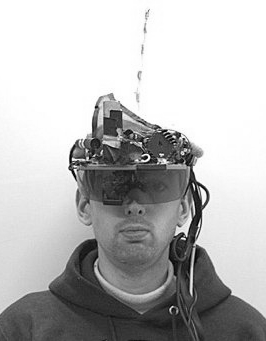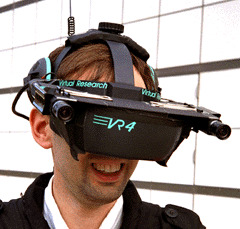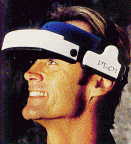 WearComp6).
The copper mesh shield is grounded and also forms part of the ground
plane for the antenna.
WearComp6).
The copper mesh shield is grounded and also forms part of the ground
plane for the antenna.
Shields for the high voltage are also a good idea (see the copper mesh
I have on
 WearComp6).
The copper mesh shield is grounded and also forms part of the ground
plane for the antenna.
WearComp6).
The copper mesh shield is grounded and also forms part of the ground
plane for the antenna.
Most cheap camcorder CRTs cannot display sharp text in an 80 column display. WearComp2 based on a 6502 processor, had video output with 40 characters per line of text, and only uppercase text. This worked quite well worn on my back with a CRT over one eye, but not with an 80 column card, as the text became too small, resulting in considerable eyestrain. Some better CRTs (like the viewfinders from high-end cameras rather than camcorders) can display 80 column text quite well. My 1980 CRT-based system still displays 80 rows of text quite nicely.
Unfortunately, computers generally no longer output video like the Apple ][ and Amiga computers used to do. Now you need to buy a VGA to NTSC converter. I bought an AI Tech VGA to NTSC converter for $249; it runs on 9 volts, and draws 1/2 amp. More recently there are smaller VGA to NTSC converters, and the power consumption can be reduced considerably. See the WearComp6 howto (wearhow) guide).
If you only need it to work inside X (e.g. don't mind not seeing BIOS and textmode), you can connect directly to TV. This is quite easy to do. There used to be a good summary of it on the WWW, at http://www.sput.dsl.nl/~rob/, but this link doesn't work anymore, (Rob's page on how to connect directly to TV sets, and other useful info) neither does the mirror site, http://www.signature.nl/~rob/, but the essential portions of this info (e.g. specifics of the TV connection) is available here, http://wearcam.org/wearhow/tv-x.html
Of course images display well on CRTs; although the screen is not in color, the tonal range is quite good. In fact, the tonal range of an old CRT taken from the curb on garbage collection day is much nicer than many expensive LCD displays.
Liquid Image Corp has been very helpful in terms of providing information, and in terms of custom work on small numbers of these units.
Liquid Image Corporation (204) 988-3003 (204) 988-3000 (204) 988-3050 Fax liquid@liquidimage.ca http://www.liquidimage.ca/
Although there is no means to input separate images to each eye, the device is outstanding in applications where there is a single (mono, as in non-stereo, not to be confused with monochrome which the unit is definitely not) video signal.
Color rendition is really good. Text is not as sharp as on a CRT or other high resolution device, but the color fidelity is such that pictures of natural scenes look quite good.
Because of its light weight, the apparatus is also very comfortable to wear for many hours. It is built into eyeglasses rather than a helmet type design, and this makes it more natural to wear, and also more acceptable to those who don't want to "mess up their hair".
See a mirrored copy of their main www page.
Colorado : 20361 W. Thunder Rd Colorado Springs, Colorado 80908 USA Tel : (719) 495-3254 Fax : (719) 495-8508 E-Mail : klugex@pcisys.net Florida : 1408 Sw 13th Court Pompano Beach, Florida 33069 USA Tel : (954) 941-8066 Fax : (954) 941-3426 E-Mail : albatech@skyex.com http://www.skyex.com/albatech/
1.0in CRT: resolution 250*300, 6kV; complete composite viewfinder.
(this from miyota... buy and sell closeouts, only 70 units got; now down to 50)
THE 1 INCH CRT IS NOW SOLD OUT!!! :-(
5" Amber or B&W $25.00
5" Color Monitor $39.00 or 2 for $69.00
Flat faceplate
320 x 200 dot resolution
CGA & Hercules Compatible
12VDC Operation
15.75 KHz Horizontal Frequency
60 Hz Vertical Sync. Frequency
Open Frame Construction
Standard Interface Connector
Degaussing Coil Included
Mfr. Samtron
http://www.digisys.net/timeline/blowout.html#monitor
The following info is now obsolete (Private Eye no longer in mass production) Phoenix group, phone=516-349-1919; fax=516-349-1926 $1500 for 280down, 720across, with driver board approx. $4000 768down, 1280across (not available yet) will make higher-resolution displays on request.

Having worn it for extended periods of time, over a 2 week period, I found it to be quite comfortable. The display quality is quite high, close to that of a good television monitor (e.g. almost as good as a color CRT). Adjustment knobs for head size make it very easy to have someone else quickly try it on. Two separate inputs are provided, one for each eye, and there is a stereo/mono switch which makes it easy to quickly test a single video input, feeding it to both eyes. There is a buffered monitor output on the left channel to plug into an external TV set or the like. The input can be either component (YC) or RGB RS-170 video.
The supply voltage is 16 volts. The VR4 comes with a lightweight, high-efficiency switching power supply for operation from 120 volts AC. I found it to work quite well from one of my wearable AC outlets, though it is also quite easy to build a DC to DC converter from 12 volts to 16 volts so that it can be run from a standard 12 volt battery.
The VR4 is probably one of the best choices for color RS-170 video display, but is not quite sharp enough for display of small fonts on a computer screen.
Model: VR5 Display: Dual 1" CRTs with color shutters FOV: 53x at 100% overlap; 72x at 50% overlap Resolution: SVGA or better Input: Field Sequential (RS-170) Weight: Under 2 lbs. IPD: Adjustable 52mm - 74mm Eye relief: Adjustable, users may wear glasses Available: September '95 Price Point: Under $20,000 Virtual Research Systems, Inc. V6 US$ 7.900, V8 US$ 13.500 2326 Walsh Avenue Santa Clara, California 95051 Tel: (408) 748-8712 Fax: (408) 748-8714 E-mail: info@virtualresearch.com

However, using the Personal Assistant for an extended period of time, I find that the green display is a little annoying -- after taking the Personal Assistant off, I can read 3-D comics without 3-D glasses. This is because my display eye sees everything with a magenta cast (after having been stimulated by green), while the other eye sees normally (which even looks a little green by comparison).
Possible work-around: change backlighting to white, although the lcd only works with monochromatic sources (need an lcd that works with broadband sources).
I also found the Personal Assistant display slides down my face, and I have to keep pushing it back up every couple of minutes, unless I set the tension high (but that causes it to be uncomfortable due to the pressure on my head).
Work-around: additional supports around the top of the head to prevent it from sliding down.
Result with both these work-arounds: a very comfortable display with good clear crisp text and greyscale image display capability.
I find these ``cool shades'' are comfortable to wear for many hours at a time,
and provide a convenient display for video:

There are even miniature earphones that can be stowed on the sides when
not in use.
While the image is not razor sharp (so they're not too good for
displaying text), the small size, comfortable design, and
``normal'' appearance makes them
quite useful for image display. They are neither intended, nor marketed
for virtual reality, but, rather, are meant for image
display (e.g. for use as a camera
viewfinder).
They are available in either the left-eyed version or the right-eyed version (you need to specify at time of purchase because they cannot easily be reversed.
The operating voltage is 6, and they come with battery and charger. The company wisely used a standard battery type (exactly like those used on a Sony HandyCam) rather than introducing yet another battery type. Thus if you already own a Sony HandyCam, your battery management will be simplified.
My time wearing the Virtual Vision totals hundreds of hours, and they have been very reliable. The only small flaw is the connector from the eyewear to the control box, which you may want to strain-relief by attaching a small metal support with hot-melt glue and wrapping to the plug with gaffer's tape. Otherwise, the wires may weaken over a year or two of heavy use, and break off inside the plug. Of course, new cables are available (changing the cable is quite easy with a phillips screwdriver to open up the eyewear), but a simple strain-relief will eliminate the need to keep spare cables around.
There are 3 different visors available, dark, medium, and light.
Virtual vision refers to their product as an ``augmented reality'' system, because you see through the glasses and augment the real world with what appears to be a very large television set quite far away. The focus is adjustable so that eyestrain can be minimized, and I've found that there is sufficient range of adjustment that people who have relatively strong prescription glasses can see Virtual Vision without their glasses.
Virtual Vision also comes with a tuner module which may be removed when
not in use. The tuner facilitates reception of standard broadcast
television, or use with a downconverter to receive amateur television (ATV).
Its external antenna jack makes it easy to plug in an ATV downconverter.
Alternatively, if you're not
squeamish regarding the sight of bare components,
you might want
open it up and modify it to receive ATV directly.
Using Virtual Vision with ATV
is a nice way to stay in touch with a
partner -- seeing eye to eye.
The sound quality of the Virtual Vision is excellent; it has two very
small earphones that can be disconnected if desired, or they can also
be stowed out of the way (in small holders
moulded into the eyewear) but remain connected when not in use
when rapid deployment capability is desired.
The sound comes in the standard audio subcarrier of the received signal
in RF mode (just like a normal TV set).
There is an antenna jack in the tuner.
When you plug video into the
external video input jack, the video automatically switches from RF
to baseband. Likewise with the sound. You can switch the sound and video
independently from baseband to RF. For example, you can plug
in an external baseband video input (e.g. camera) and listen to the
RF (e.g. broadcast television) sound at the same time by having
nothing plugged into the audio jacks.
Virtual Vision, Inc. 7659 178th Place N.E. Redmond, Washington, 98052 tel: 206 882 7878 fax: 206 882 7373(I also observe that 1800 619 4680 can get there)
Cost is under $1000 (e.g. list is around $900; should be able to get it for around $700).
Virtual Vision sold the rights to the Virtual Vision Sport Glasses to the following company:
http://www.vetco-inc.com
VETCO Electronics
13029 Northup Way 7866 Southwest Nimbus Ave
Bellevue, WA 98005 Beaverton, OR 97008
Phone (425) 869-7025 Phone (503) 574-2299
Fax (425) 881-5064 FAX (503) 469-0520
E-Mail: vetco@vetco-inc.com E-Mail: vetc0@gte.net
See also,
http://www.virtualvision.com/
Virtual vision has evolved into Virtual Image Dislays Inc and Seattle Sight Systems. The new system described in http://www.seattlesight.com/sss.html is quite innovative. Seattle Sight Systems, Inc. , starts at US$ 3500
http://www.seattlesight.com/gpseries.html 14150 N.E. 20th Street., #313; Bellevue, WA 98007 Telephone: (425) 643-1966; Fax: (425) 643-9976 General inquiries may be directed to: ssightsys@aol.com
See also, a picture of Virtual Vision's new VCAP.

The PT-01 is very similar to the Virtual Vision (it even has the same style of connector, so if you already have a Virtual Vision, you can plug the PT-01 directly into the Virtual Vision belt pack, which means that you can use the PT-01 as a tuner with the Virtual Vision belt pack).
The PT-01 has the same high-quality color rendition as the Virtual Vision display. Basically the PT-01 is a high-quality NTSC monitor, with sufficient quality of color rendition to facilitate its use in adjusting the color balance of cameras, etc. The spatial resolution is not quite high enough to read 24 rows of 80 column text.
The PT-01 delivers the identical NTSC input to both eyes, so that eyestrain is reduced during long viewing periods, and the PT-01 also fills a greater angle than the Virtual Vision, but you can't see through the PT-01, so it may be less or more preferable than a Virtual Vision depending on your application and preferences. Basically I use the Virtual Vision when I want to monitor a signal while walking around (e.g. for testing video transmitters by walking around and looking at the signal quality), but the PT-01 when I want to concentrate more on the video signal and less on the surroundings. This finding appears consistent with the manufacturers' intent, because the PT-01 requires a wall-socket (e.g. comes with a 7.5 volt wall adapter but no battery) while the Virtual Vision is battery powered. Of course it is a simple matter of obtaining a 7.5 volt battery or running the PT-01 from the VirtualVision belt pack to liberate it from being tethered to the AC. However, care should be used -- perhaps it is just as well it is tethered because of the obvious danger of walking around with your eyes covered up (unless you're using it for a `reality mediator' as I often do).
The PT-01 swings up out of the way, and you can still see the screen when it is pulled out and swung up out of the way.
The sound quality of the PT-01 is superb, and it has standard RCA inputs for stereo sound (3 RCA jacks, 1 for video, 2 for sound). There is also a BNC connector for video input which often comes in handy. Having both BNC and RCA inputs for the video was a wise design decision, and the rugged metal construction of the belt pack is consistent with the high quality that is typical of equipment that has BNC connectors on it, as opposed to the lower quality "consumer grade" equipment that typically only has RCA connectors.
If you're serious about video in the field, you probably want to get both a Virtual Vision and a PT-01 so you can adapt to any situation you might encounter. Both of these units together can be packed into a carrying case that is smaller than most color monitors, and definitely much less weight to haul around.
Look at a diagram of how this display is used.
PT-01 email: Optix1@aol.com http://www.optics1.com/HMD.htm
01 Products, Inc. 3050 Hillcrest Drive Suite 100 Westlake Village, CA 800-538-3008 805.446.1453 FAX:1+ 805.373.8966 A division of Optics 1, Incorporated 3050 Hillcrest Drive, Suite 100 Westlake Village, CA 91362 Phone: 805/446-1453 (800-538-3008) Fax: 805/373-8966 e-mail: hmd@optics1.com1370 Willow Road Suite 101; Menlo Park, CA 94025-1515 PHONE: 1-800-339-5287 650-323-8407; FAX: 650-323-1742 E-Mail: info@i-glasses.com; http://www.i-glasses.com (was http://www.vio.com)

other head mounted display pages/resources:
other resources... from emo@ai (with stereo color lcd interleaved pixels...) http://www.imaginative.com/VResources/ http://www.imaginative.com/VResources/vr_hardw/vr_hardw.html http://www.cms.dmu.ac.uk/~cph/VRbib.html http://vr-atlantis.com/vr_systems_guide/vr_systems_list2.html
Prof. Steve Mann University of Toronto Department of Electrical Engineering 10 King's College Road, Room 2001 Toronto, Ontario, Canada, M5S 3G4 416.946-3387 mann@eecg.toronto.eduhttp://www.eecg.toronto.edu/~mann